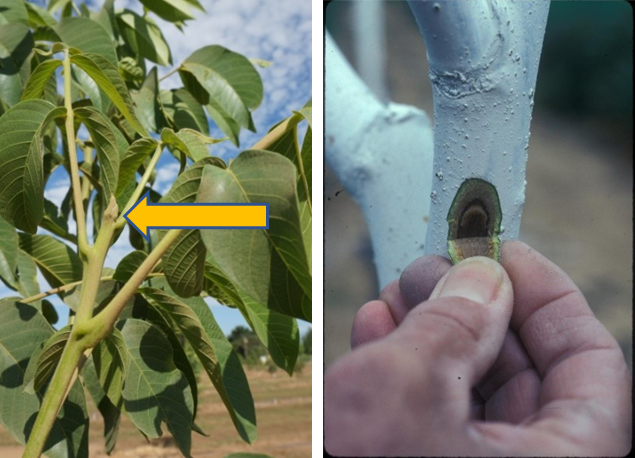Luke Milliron, UCCE Farm Advisor Butte, Glenn, and Tehama Counties; Jaime Ott, Orchard Systems Advisor, Tehama, Shasta, Glenn, and Butte Counties; Janine Hasey, UCCE Farm Advisor Emerita; Joe Connell, UCCE Farm Advisor Emeritus
Damage from a sudden autumn freeze can occur when trees experience freezing temperatures prior to going into dormancy. With sudden autumn freeze damage occurring in three of the last five years, preparing for these freeze events needs to be a regular part of every walnut grower’s summer and fall orchard operations. The best approach to escape damage from a fall freeze is to have frost alarms ready and turned on by October 15, completely rehydrate trees after harvest, and actively irrigate during frost events.
Steps to prepare:
- Tender new growth is most vulnerable to freeze damage: prevent trees from pushing late-season growth by cutting off N applications by mid-August (young trees) or early September (mature trees).
- For young trees, withhold irrigation starting in early to mid-September, waiting to resume irrigation until after a terminal bud (left photo) is set on the trunk. After the terminal bud has set, resume irrigation to avoid tree stress and defoliation. For bearing trees, terminal buds usually set as a side effect of the water cutoff done ahead of harvest.
- Keep groundcovers cut to 2 inches or less starting in mid-October. This allows sunlight to reach the soil surface, storing heat for a warmer orchard through the night.
- Rehydrate trees immediately after harvest, and actively monitor soil moisture and freeze predictions (usually from mid-October through December) until trees are acclimated to frost (see note below). Trees with adequate soil moisture are better able to withstand low temperatures without damage than trees in dry soil. This is because water-filled spaces in the soil conduct and store more heat than empty airspaces. If a freeze is predicted and the soil is dry, it should ideally be wetted 2 to 3 days before a freeze event. Light irrigation to moisten a dry soil surface the morning before a frost will help obtain the greatest heat storage for re-radiation at night (if there is no ponding going into the freeze event).
- Some growers with the ability to actively irrigate during sudden autumn freeze events have reported great success in preventing damage. We know from work in almonds that active frost protection can achieve as much as 4 degrees of warming with solid set, 1-2 degrees with micro-sprinkler, and maybe even some benefit running a drip system.
When do you no longer have to worry about preparing for the next freeze? Fully dormant mature healthy trees can tolerate temperatures to the low 20’s (°F) or below. We believe walnuts acclimate by having the first mild frost events in autumn with lows near or just below 32° F. However, we do not know how many mild freezes are required to acclimate trees in autumn. If the soil is dry ahead of the third, fourth, and maybe additional freeze events – it’s better to irrigate and be safe if you can do so. In addition, consider keeping up your freeze response program longer into fall or early winter for younger orchards with lots of current season’s growth.
If you suspect freeze damage occurred, cut into the branches shortly after the freeze event and check the tissue for drying or browning (right photo). Sunburn after freeze can further damage tissue on the southwest side of the tree. Paint the southwest side of damaged trees with 50% diluted (1:1 water to paint) white interior latex paint. Painting up to a week after the freeze event can reduce additional damage by half or more. You can learn more about freeze recovery in our article 2020 Walnut Freeze: Road to Recovery.

Left: Withhold irrigation until a terminal vegetative bud sets on the trunk. Right: After a severe freeze event cut into the southwest-facing trunk, looking for dark brown discoloration of the cambium (photos: Janine Hasey).


Leave a Reply